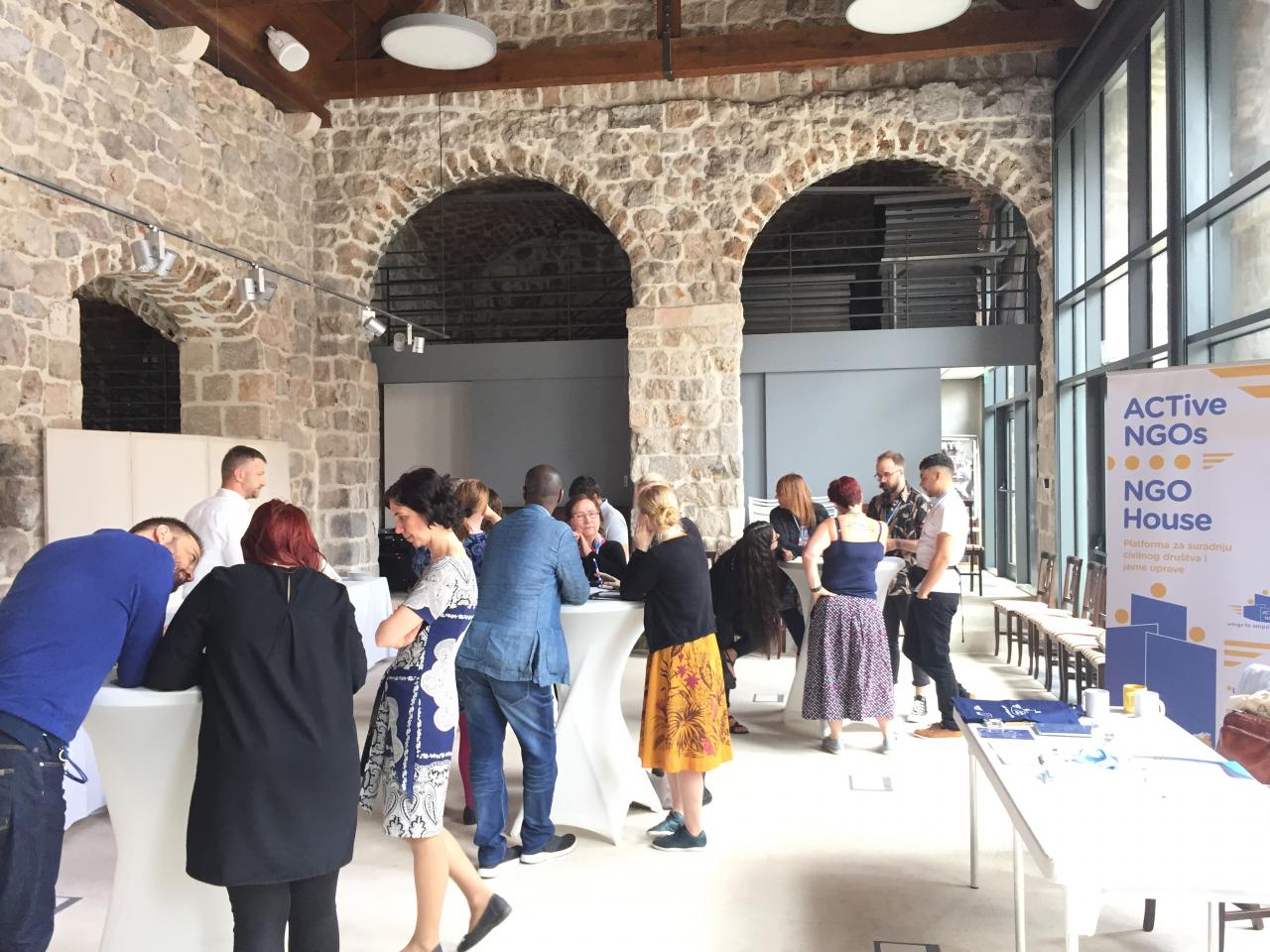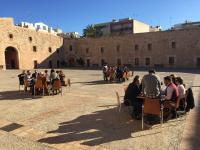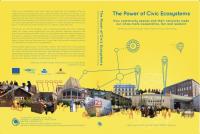
After three years of joint work, the ACTive NGOs URBACT Transfer Network has arrived to its final months. In these three years, the cities of Riga, Brighton and Hove, Dubrovnik, Espoo, Santa Pola and Syracuse have been working together on creating spaces for civic initiatives and stronger civic ecosystems around them. This article explores the broader context of this work and some of the key achievements of the partner cities.
ACTive NGOs network brought together cities to create their local version of Riga’s NGO House. The NGO House in Riga was created to act as an interface between the municipality and civil society, by offering space to NGOs for their events, connecting them through networking activities and helping them improve their capacities with the help of trainings. It serves as a node in the city’s local civic ecosystem. The ambition to create such nodes was shared by a number of cities that joined the ACTive NGOs network. The city of Santa Pola in Southeast Spain was looking to include new buildings into its network of spaces accessible for citizen activities. Dubrovnik in Croatia was in the process of building a new governance structure for its former quarantine complex, linking it to other spaces across the city. Syracuse in Sicily was about to relaunch its Citizens House and Youth Centre and link them in a network with the freshly opened Urban Center. Espoo in Finland was looking for ways to improve the capacity of NGOs working with migrants and refugees, while Brighton and Hove in the Southwest of the UK was seeking to create more straight links between municipal services and civil organisations.
“Transferring” a good practice does not mean a straightforward, copy-past action. The Riga NGO House is a specific model that is strongly rooted in its own administrative, policy, economic and social environment. It was clear at the beginning of this process that there could be no 1:1 copies of the NGO House in the partner cities. Each city has its own particular history, driving forces and inertia in public-civic cooperation. Furthermore, in contrast with Riga’s fully municipality-financed and managed NGO House, many cities were looking for a more horizontal governance model with more responsibility on the side of the NGOs.
In the same time, learning from Riga’s NGO House and the local experiences of other partner cities could bring specific, custom-made knowledge to each municipality and local stakeholder group. Therefore, in order to be able to create NGO Houses or civic nodes that are integrated in their respective territories, we identified a number of elements or building blocks that constitute these spaces and their relationships with citizen initiatives, civil society organisations and municipalities.
Mapping civic initiatives and organisations is a key step to better understand the activities, needs and ambitions in a city or neighbourhood. Exploring their possible links and building incentives that help them grow synergies and cooperate leads to stronger local civic ecosystems. Space is always a crucial component to an ecosystem: designing mechanisms that help initiatives access and share public or private spaces for their activities is a great contribution to the sector’s wellbeing. Innovative economic models that help pooling resources from a community and channel economic flows into citizen initiatives can provide civic spaces with relative autonomy and resilience. New, inclusive and participatory governance structures allow the shared management of spaces and resources, connecting a variety of different organisations, institutions and venues across the cities. Capacity building programmes help NGOs and social economy initiatives to further develop their work, improve their profiles and potentially scale up or multiply their activities.
In a series of transnational meetings and continuous local work, the ACTive NGOs network explored these building blocks by following a pre-designed learning trajectory. This trajectory was defined according to a structure that allows partners a continuous, gradual construction of interventions, programmes and policy tools, focusing on the partner cities’ needs and their abilities to adapt some of the NGO House features in their specific context. This approach brought a variety of results in the partner cities.
Building on its “distributed” set of community assets instead of a centralised NGO House, Brighton and Hove brought together local organisations and initiatives of East Brighton into a more compact and interconnected network where they could have a better sense of the events and services of their area. The What’s ON BN2 Guide, a printed and digital publication accompanied by a social media group “helped to bring East Brighton partners together, celebrate the range of opportunities in the area and encourage and support more residents to get involved,” explained Indi Hicks of the Brighton and Hove Municipality. This stronger network, facilitated by a localised communication strategy, now serves as the basis for a governance model for the area where different organisations, initiatives and communities can jointly shape the future of East Brighton.
Eager to formalise the connections within its rich cultural sphere, Dubrovnik went through the learning trajectory in a systematic way. An in-depth mapping of local initiatives, “as well as helping the NGOs connect and share resources, it helped the City administration to better understand the ecosystem of the civil society,” described Petra Marcinko, Dubrovnik’s ULG coordinator. A series of workshops and discussions helped in the establishment of governance protocols for Platform for Lazareti and the Youth Center, the city’s two main civic spaces. These protocols did not only regulate “the spaces shared by the Platform’s organisations but also defined the criteria and rules of lending spaces to other NGOs and citizens for their activities,” summarised Petra.
Consistent its service-oriented logic, Espoo focussed on making access to underused spaces across the city more simple for NGOs and citizen initiatives. With the help of a digital platforms, a service map and a space sharing pilot was designed by ULG members. In addition, service design workshops were offered to a number of immigrant backgrounded NGOs taking part in the project, “helping NGOs’ professionalisation by supporting them in focusing on their work and relationship with their members,” highlighted Maria Tiilikkala, Espoo’s Civil Society Coordinator.
Inspired by a variety of practices in Riga and other cities, Santa Pola launched a new communication system for associations. This new digital tool allows associations to give visibility to their activities, build connections with each other or make a reservation for municipal spaces. This database of associations, updated through the digital platform, has extended not only the municipality’s knowledge of local civil society but also helped associations to get to know each other. The database, with the words of Mari Carmen Gonzalez, the local ULG coordinator, “constitutes a key element in the development of local policies to support associations.”
Syracuse’s work focussed on formalising the use and sharing of already existing civic spaces across the city. The local stakeholder group’s intensive work and more than 15 meetings led to a co-designed and co-written Protocol of Understanding, signed by the Municipality and 29 associations active in the area. The Protocol “defines the places, responsibilities and governance of a system made of the three Houses of Associations and Volunteers,” explained Caterina Timpanaro, an expert who supported Syracuse in the process. After signing the protocol, the associations elected their governing bodies and began to operate autonomously.
The project also brought improvements to Riga, the Good Practice city. Besides improving the services of the NGO House and helping associations cooperate better, Riga also aimed to enhance access to its activities. Inspired by other cities’ work on organising activities outside municipal settings, Riga brought the activities of the NGO House to festivals organised in two different neighbourhoods of the city. ”While the project partners were looking for how to find common spaces for NGO activities and support NGOs, Riga was looking for ways to ’get out’ of the NGO House,” Zinta Gugane of the Riga NGO House summarised the city’s challenge.
In addition to local work, transnational meetings also made a strong impact on local stakeholders. As the network insisted on helping the travels of as many people as possible, the international visits brought together different members of the ULGs. Traveling together allowed municipal officers and their civil counterparts to establish new connections and partnerships, thus strengthening their local ecosystems. By providing a “neutral space” for generating ideas and solutions, ACTive NGOs facilitated open conversations and the development of trust, that in turn “helped the municipal and community groups to come together with a more equal power balance,” recalled Indi Hicks. This experience was echoed in other cities; according to Petra Marcinko, communication has become better at three levels: “between the members of the NGOs in the centers, between the two centers, and between the centers and the City of Dubrovnik.”

Transnational meeting in Santa Pola (Spain) in February 2019
The project ACTive NGOs was meant to last from the summer of 2018 until the end of 2020 and was prolonged until the summer of 2021 because of delays caused by the Covid-19 pandemic. While in 2020 most local work and transactional exchange had to move online, it did not mean that the year was lost for public-civic cooperation. On the contrary: all across Europe citizen initiatives, NGOs and social economy projects turned out to be essential actors in sustaining welfare networks and guaranteeing access to basic services for people in financial distress or more vulnerable to the virus. Self-organised solidarity networks, often coordinated with municipalities, the private sector and philanthropy organisations have demonstrated that today, more than ever, we need strong, interconnected civic ecosystems that can react quickly to emerging challenges, help our societies adapt to changing circumstances and make our cities more cooperative, fair and resilient.

Besides a number of project deliverables, the experience of ACTive NGOs is also told in a book. The Power of Civic Ecosystems is based on the testimonies of the participating cities Brighton and Hove, Dubrovnik, Espoo, Riga, Santa Pola and Syracuse, telling their learning and exchange experiences as well as stories from their local stakeholder networks. In order to put this work in a broader context, the book also collects inspiring practices from other cities, ranging from municipal policies to citizen initiatives and professional methodologies, exploring mechanisms of stakeholder mapping and ecosystem-building, frameworks to access to public and private spaces, models of economic resilience, structures of participatory governance, and processes of capacity building. This collection benefits from a pan-European perspective to look beyond the individual initiatives and organisations, and understand their potential in their connections with other actors. It also offers an overview of a diversity of approaches, mechanisms and methods of connecting different components of local civil society to achieve more together than the sum of their individual accomplishments.
The preview of the book is available at https://issuu.com/eutropian.org/docs/the_power_of_civic_ecosystems_preview and the full book will be published in June 2021 at https://cooperativecity.org/the-power-of-civic-ecosystems/
Levente Polyak
Lead Expert

